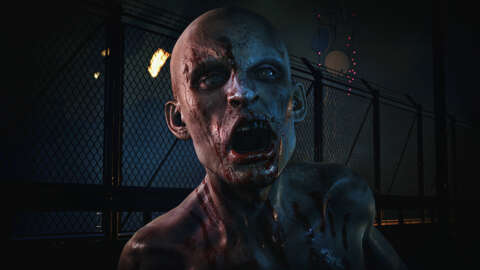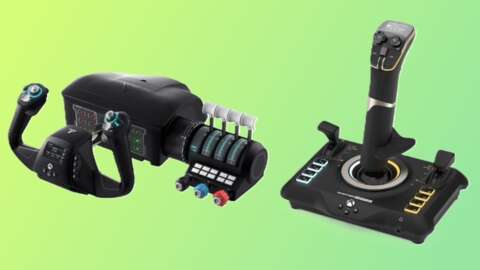Sometimes people talk about zombie games with an air of fatigue, like they’ve had their fill and are ready to ignore the concept, but you’ll never catch me sounding that way. I play as many as I can find, and in particular, my favorites in the zombie genre tend to share a common trait that I find extremely important. I recently got to play about 90 minutes of No More Room In Hell 2, an open-world, first-person co-op zombie game for up to eight players, and it scratched that vital itch in the way I’d hoped it would. No More Room In Hell 2, like many of the best zombie games, presents a desolate and desperate world. By pulling no punches, it’s immersive in all the right ways.
No More Room In Hell 2 (NMRIH2) is a sequel to a cult-favorite zombie game that’s been on PC since 2011, hiding in the shadow of Left 4 Dead. Like the original game, and so many others, this sequel is Left 4 Dead-inspired, though it’s how it diverges down a path of its own that reveals the game’s best qualities. Played on a huge open-world map that blends thick forests, ranger cabins, firewatch towers, and a massive power plant that serves as the level’s end goal, each of a game’s eight players spawns alone with a few supplies nearby, a few points of interest marked on their map, and the full world to explore.
Watching zombies bust through the windows when I was already barely holding it together was like something right out of a Romero movie.
But exploration must be done carefully and with great consideration for every action. In my time with the game, stamina was quite limited, especially in combat, where I could only get in about four swings with my metal pipe before I had to retreat while I caught my breath. Early on in my demo, as I scoured picnic tables, outhouses, and campgrounds for flashlight batteries, ammo, and medkits, I carefully crouched, lights off, around small packs of undead. My time in the original game had primed me to expect an unforgiving experience, and that kept me from having to learn that the hard way early on.
The zombies in this world are the classic stumbling kind, rather than the runners of more recent fiction like 28 Days Later and World War Z. Put another way, they’re more Dawn of the Dead (1978) than Dawn of the Dead (2004). However, even a single zombie presents a serious close-quarters threat. They have scary-good closing speed, and those with red eyes are especially tough, often surviving many melee blows and even some body-part-removing blasts of my shotgun. As I desperately chopped away at these more durable undead, layers of flesh and bone fell to the ground like a ceiling caving in from severe water damage. This gory effect is not new–Dead Island 2 and Dying Light 2 both perform a similar trick–but it’s welcome in as many zombie games as can offer it.
The original game’s infection system, which turns some wounds into a countdown until you’re zombified, is set to come to the sequel later during the early-access period that begins on October 22, but even in this early build, permadeath is in place and threatens to wipe out all your character’s progress. Dying means turning into a zombie yourself, which you no longer control, leaving your allies to put you down like a common zed before you start a new character from scratch.
That makes every hit you take feel costly, as your inventory space is limited, and it’s unlikely you have a stockpile of healing items–even if you do, you’re therefore lacking in other necessities as a trade-off. Gunplay is similarly uncharitable. In my time with the game, I had a revolver and later found a shotgun, but ammo was hard to come by, and firing either of them often seemed to draw in more zombies than any headshot was worth. It didn’t take long before I learned to check every corner when I’d open a door. I also quickly trained myself not to stop moving for very long, and if I had to do something like heal or take inventory of my supplies, I first climbed onto a truck’s roof or some other structure that gave me a brief moment of reprieve.
NMRIH2 is a strength-in-numbers experience, and one of the great thrills I experienced in my early hands-on session was finding another survivor. Creeping alone through the woods and catching a glimpse of another flashlight dashing across the trees was a sigh of relief in both of my lengthy attempts at the game’s difficult mission. Except for the feat of maybe not dying, you can’t do much by yourself in NMRIH2, so even as you spend your early minutes scavenging and trekking toward a loot stash on your map, the first order of business is really to group up. With eight players to a map, your squad is somewhat incomplete until you’re all together, though it’s not exactly a requirement that you ever do anything with another player; going alone is a death sentence, in all likelihood, but it seems the game welcomes you to try if you’re intent on doing so.
The world in NMRIH2 is not a “post-apocalypse,” Torn Banner Studios told me. The story is set as the world is mid-downfall–a car that’s careening off a rain-soaked highway, but not one that’s yet wrapped around a tree. Therefore, missions are focused on your crew of survivors–each of them dressed like first responders–trying to stop the skid and get critical infrastructure, like a local power plant, running again. There’s still hope. The world hasn’t gone to hell quite yet, which helps contextualize your missions as extremely important for the fate of your local population–and perhaps humankind.
With eight-player co-op, you’ll have a larger group of allies than most similar games allow, but it still feels like everyone needs to work together to survive.
All of these qualities combine to provide that aforementioned and most crucial trait of zombie games: despair. Video games are usually power fantasies, but horror games–and especially zombie games–are designed with the opposite in mind. What if you’ve just watched four of your friends get wiped out and a fifth is begging to be revived? Do you risk your character trying to save them? What if you’re just too tired, too slow, or too weak to continue? What do you do when just two zombies were intense, and now you’re staring down 30 or more outside a mission-critical location? You can fight, but not forever. You can hide, but they’ll find you. You can try and wait it out, but the dead don’t sleep.
Feeling the odds stacked against you but somehow making it out alive (with hopefully a few living allies standing beside you) is the memorable stuff of horror movies, and it’s what could land Torn Banner’s sequel in the uppermost tier of zombie-game greatness. After the first game flew under the radar for over a decade as a flawed but immersive hidden gem, my early-access preview of No More Room In Hell 2 left me feeling like it’s about to make a much bigger name for itself.
Launching into early access on October 22, you can check out No More Room In Hell 2 on Steam and the Epic Games Store.



